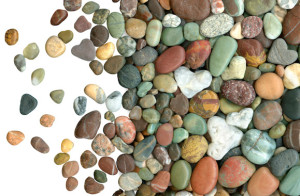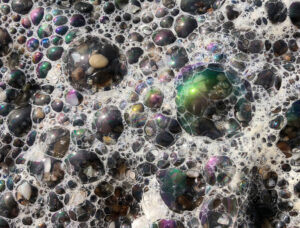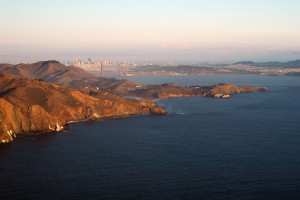Josie Iselin’s passion for discovering natural treasures along the shore started young, and later evolved into her life’s work: turning ocean objects into art through her popular photography books. We spoke with Josie as she prepared to release her seventh book An Ocean Garden: The Secret Life of Seaweed in March 2014.
When and where did you start beachcombing?
I grew up spending summers on the coast of Maine. As kids, my siblings and I spent countless hours on rough, stony beaches and always brought home sea glass, odd stones, driftwood, or lobster pot buoys. As soon as I moved to California in 1989 I would spend lots of time on Bay Area beaches. With young children, there’s no better place to be!

How did you capture your beach finds?
Twenty years ago I started using my desktop scanner to capture images of objects around my house, many of which were….stones, of course. This evolved into the book Beach Stones, which was released by Abrams in 2006. Once the Beach Stones book came out I discovered how many people, like myself, collect heart-shaped stones, so that was the genesis of Heart Stones (2008).
A later book, Beach: A Book of Treasure (Chronicle, 2010), was my effort to document the full range of what we find at the beach, from sand, to sea glass to seaweed and kelp, to feathers, driftwood, and other detritus. I wrote the text of that book myself, delving into the science of what we find as well as ranging into Japanese aesthetic philosophy, the history of natural science museum collections, and musings on how to be better stewards of this place of inspiration we call the shore. One emphasis is that we must be polymaths, adept at many disciplines, to learn both about and from what we find at the beach.

What inspired your latest book?
On the Duxbury Reef in Bolinas many years ago, I held an innocuous scrap of seaweed up to the sky and was blown away by the intensity of color—deep magenta—and fabulousness of form. Then and there I was determined to get seaweeds back to my studio and onto my scanner. I started my seaweed investigations in Beach: A Book of Treasure but soon knew I needed to devote an entire book to these magnificent and varied organisms, and so we have An Ocean Garden: The Secret Life of Seaweed, (to be released by Abrams on March 11).
You describe your latest book as “groundbreaking”. Why do you say that?
The images are more eye-popping, and the book contains substantially more information than previous books. I cover such topics as the evolution of color, the architecture of seaweed, community in the intertidal zone, the tide, the story of Kathleen Drew-Baker — the woman who solved the mystery of seaweed reproduction — and much more. In researching the text for this book I collaborated with Kathy Anne Miller at the UC Berkeley Herbarium, which has the foremost collection of marine algae on the west coast. I was determined to write correctly and insightfully about the biology of seaweed and kelp but avoid the jargon: I wanted to make the science deeper while remaining personal and accessible to the average beachcomber.
Seaweed also presented quite a challenge to the notion of what can go on a flatbed scanner. I put both wet and dried specimens onto the glass plates.
Where did you find the seaweed specimens featured in the book?
Many of the specimens are from here in the Bay Area, found as drift on local beaches like Fort Funston, Bolinas, Point Reyes, and along the San Mateo coastline. I hope to open people’s eyes to the marine algae right under our noses in the Bay Area intertidal zone.

Who are your heroes?
My two heroes are Rachel Carson (her three books on the ocean and the ocean’s edge are so beautifully written and pertinent today) and Kathy Ann Miller, curator of marine algae at the UC Berkeley Herbarium.
What is your favorite place to go beachcombing?
My favorite beach is Fort Funston. I walk there in the mornings twice a week. I also feel very close to the Duxbury Reef in Bolinas. I am part of the Rocky Shore Naturalists group that does monitoring of marine protected areas and especially the Duxbury Reef. I have some Feather Boa kelp holdfasts on the reef which I visit regularly throughout the seasons.
How much plastic do you find on the beach these days? Has the amount you find increased since you started doing beach art?
A lot! There have been no storms this winter so the wrack line is empty of fresh marine debris — no storms to churn up the kelp beds and wash them ashore as is normal for winter-time–so the high tide mark is strewn mostly with small bits of plastic, plastic bottles and all sorts of trash. I don’t think it is much worse than in previous years, but it has been bad for many years. I don’t think there is as much sea glass as there used to be.
I have quite a collection of plastic beach finds, but I am a mere novice on this end! There are some amazing collectors of, and artists using, beach detritus. I always carry a bag for collecting plastic and old balloons from the beach on my morning walks.
What should people let themselves keep, and what should they allow to remain on the beach?
Every beachcomber these days has to be aware of the beach they are on and what the rules are for that beach. If it is a “marine protected area” nothing can be taken by law. On any beach or reef, it’s important not to take anything that is alive, or that might be providing habitat for anything that is alive. Dead seaweed from the wrack line on a non-designated beach is ok, though! I encourage beach explorers instead to take photographs, sketch or write about what they find. My hope is that my books can preclude having to bring all that stuff home.
Learn more about Josie Iselin and her work at her website, josieiselin.com.
>> Save The Date: Josie, whose gorgeous images grace our January-March 2015 issue, will be the special guest at Bay Nature Institute’s Annual Awards Dinner on March 22, 2015.
Click here to learn more and buy tickets.





